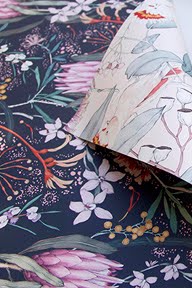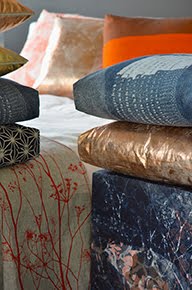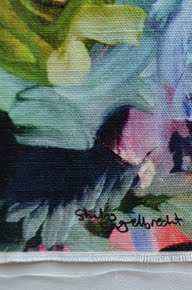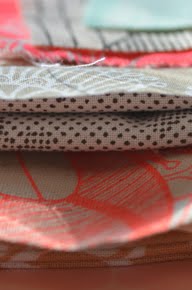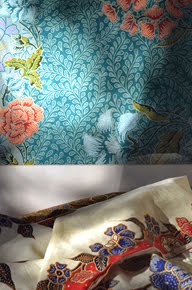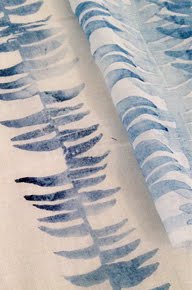The
team at Spacecraft expertly walk a kind of craft tightrope. Poised on the rim between art, craft and
design, Stewart Russell and his team constantly push the boundaries of what
they do and how they do it. That’s because, in addition to screen printing
their own artwork, and a distinct range of textile products, they also print the work of well
known Australian artists and collaborate with interior designers, urban
planners and architects. New is their norm, requiring an agile ability to problem solve and develop new skills. Where many would topple with the tension of this space, each member stays alert and adaptable, finding their stability in the unknown.
And
Stewart wouldn’t have it any other way. In many respects, such a brave approach
is a very sensible place for this wandering Scot. Early art study and a wealth of experience means he finds comfort in growth, and he has gathered a loyal team
of trained artists about him who feel exactly the same way. This studio is awake, and strongly connected to it's creative neighbours in the Melbourne suburbs of Collingwood and Fitzroy.
It's here that Stewart and his partner, Donna O'Brien, set up shop more than 15 years ago following a series of print posts in Colombo, Edinburgh and Ireland. Having met at their London art school, the couple promptly downed tools following graduation and hit the road. They found themselves in Sri Lanka during the mid 80s, where colourist and textile designer, Barbara Sansoni, quickly charged the young Russell with setting up a print studio for her, based in the country's capital.
It's here that Stewart and his partner, Donna O'Brien, set up shop more than 15 years ago following a series of print posts in Colombo, Edinburgh and Ireland. Having met at their London art school, the couple promptly downed tools following graduation and hit the road. They found themselves in Sri Lanka during the mid 80s, where colourist and textile designer, Barbara Sansoni, quickly charged the young Russell with setting up a print studio for her, based in the country's capital.
“Barbara had this art community that
was based around her and Geoffrey Bawa and a group of incredible photographers, artists, architects and writers … a cultural crowd, in a very small community, so they each did a lot of
everything. She asked me, for whatever reason, to set up her screen printing
studio,” explained Stewart. “She sent me to North India to meet Faith Singh,
who does amazing things, but mostly block printing, and she also showed
me a little bit about screen printing. Block printing wasn't an option for Sri Lanka, so I formed a sense of what
a screen printing production studio might look like,” he added.
The couple enjoyed two and a half
years creating Barbara's studio on a rubber plantation an hour and a half out of Colombo,
before working in Edinburgh for a further four. Having learned the ins and
outs of setting up and managing a studio, Stewart then developed his ability to
commission, create and display new work in a formative six year stint as the
Director of London Printworks. Based in the bold community of London's Brixton, Stewart
worked with artists and technicians and developed a prominent gallery
in the area’s epicentre. He engaged with local creatives and shared with the gutsy community, an approach that is now a hallmark of his maturing textile
business.
“We commissioned new work in a different way at London Printworks,” started Stewart. “Where a lot of new
work commissions were just about giving artists a small amount of money, we were commissioning new work without a proper budget, so the the artists would come up with an idea and, no matter how ambitious, we would find a way
to make it happen,” he continued. “We didn’t commission anyone print makers, we were commissioning people who would discuss issues, so the commissioning of new
work, and then the making of the work, was a process of upskilling the people that
worked for us – the technicians in particular.”
“When we got people who didn’t know
how to print, they would often come with a wish list that wasn’t set by the
parameters that we now subconsciously live by, such as the size of screens and
the size of the mesh,” Russell added, touching on aspects of the approach that
he then decided to replicate when he and Donna crossed the seas to Australia in 2000.
“To continue these
competencies in Australia we decided it was important to keep working with artists - even though we had decided to not look for statutory funding. I had been working with some amazing people in London and really enjoyed the processes. Part and parcel of the curatorial position was that we would also produce the work, so we started working with artists in Melbourne, usually friends or visiting artists. And
they would say ‘I want to do this’ and it would take us out of our comfort zone.
Like Brooke Andrew, coming along with an image that didn’t challenge us too
much, and then saying ‘Oh by the way, that has got to be 3½ metres by 2.8'. So
then you have got to find somebody who will make a screen that size, or a mesh
that width, all the technical aspects, and that expands our range.”
Other seeds that journeyed with the couple from London were also been sown into Spacecraft. Finding it difficult to get the table texture
he wanted, Russell settled on layers of felt, covered by high quality canvas.
Over time, these backing cloths caught inky remnants of each piece the studio
collaborated on, as well as a stable of photographic imagery that is now synonymous with the
label, such as large black and white photos of European terrace houses that are printed onto bed linen and a variety of botanical designs, including fennel, copper gum and
pepper tree. Over time, these graphic layers form artworks of their own, with Stewart
now regarding them as a type of ongoing diary project for the studio.
“When we were setting up in Australia,” ventured Stewart, “I was actually looking for some continuous rubber sheets to cover the tables in. I couldn’t find what I was looking for, so I built the surface I needed to print on with felt. I started off covering the precious felt with canvas, thinking that I might change to rubber down the track. When the distinctive look of the cloths started to emerge, I really enjoyed the results, and I wouldn’t change now because they are too important for me,” he explained.
“When we were setting up in Australia,” ventured Stewart, “I was actually looking for some continuous rubber sheets to cover the tables in. I couldn’t find what I was looking for, so I built the surface I needed to print on with felt. I started off covering the precious felt with canvas, thinking that I might change to rubber down the track. When the distinctive look of the cloths started to emerge, I really enjoyed the results, and I wouldn’t change now because they are too important for me,” he explained.
Although the incidental nature of
these works was new to him, the concept of a backing cloth as an art work was
not. “I used it as an artwork in the UK a very long time ago,” said Stewart. “It
was for a craft show – The Craft Council were inviting artists not traditionally associated with craft to be in the show. I wasn’t sure what to put in, but in
the end I put in a backing cloth sheet, something I had been keeping. I had
washed it and reused it, and presented it for the show as a sort of idea showing process, rather than showing a finished work, and that got a really good
response,” he said.
As well as acting as a visual journal
for the studio, Stewart also regards the backing cloths as a guide, saying, “They constantly teach us
about composition, and they also teach us about colour. So we have
a little archive of really interesting backing cloth pieces that we keep and
we refer to when we want to consider colour. We find accidental colour combinations and think ‘look how well
that is working’. That leads us in terms of what we see going into the store,
rather than following 'two in harmony, one opposite', or high street
colour theories. I think it is a more interesting reference point, or starting
point.”
These artworks fetch handsome profits prices, and adorn the walls of private homes, as well as architecture projects the studio has undertaken. Once a cloth
becomes too uneven with paint, or an artwork starts to make itself known, the
team work together to play with areas that might need a little bit of finish.
“Some areas you need to play around with to make it into a decent painting," said Stewart, "the areas that are awkward when you are looking at them. We are also now starting
to just wash over some aspects of the cloth and placing a print over the top,
so you have still got all of those histories written there, they are just not
as up front,” he elaborated.
So, as well as the work of artists
like Brook Andrew, Reko Rennie and Andrew Hazewinkel, a variety of birds,
buildings, leaves and historical motifs decorate the studio. A keen
Ornithologist and lover of nature, Stewart also absorbs himself in the history and cultural landscape of wherever he travels. So, on a trip to Japan, he adopted the country's traditional Hemp pattern. In Scotland, he drew
lace from the local windows, and learnt the origins of the stunning pepper tree.
“When I met with my Aunts and Uncles
in Edinburgh just before setting off for Australia they told me that Church of Scotland missionaries pepper corn tree to Australia from Peru because it was understood
that it emitted a pheromone that dissuaded flying insects. When they came to Australia, they
planted two on either side of the early churches – one to hang meat under
and one to read under,” Stewart relayed.
Both motifs sit alongside other sources of inspiration he has collected along the way. This strong and interested man is his own type of storyteller. A bit like the birds he is fascinated by, he collected the seeds of one place and shares them in others, and in doing so creates a unique and “slightly edgy” place to be.
All photos by Jodie Cheetham, Threadbound
Both motifs sit alongside other sources of inspiration he has collected along the way. This strong and interested man is his own type of storyteller. A bit like the birds he is fascinated by, he collected the seeds of one place and shares them in others, and in doing so creates a unique and “slightly edgy” place to be.
All photos by Jodie Cheetham, Threadbound








